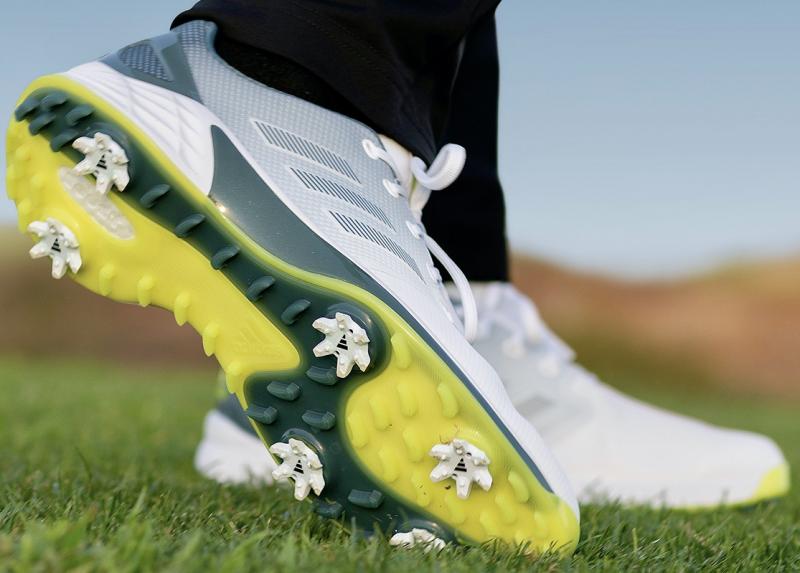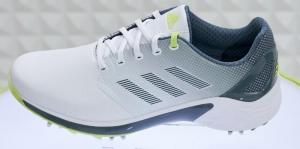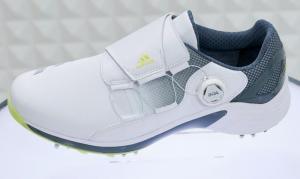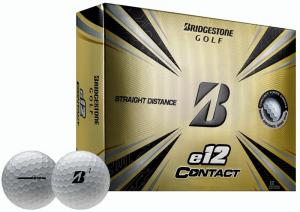Lightweight design for Adidas Golf spiked shoe
This year’s PGA Merchandise Show went completely virtual, thanks to the pandemic and understandable jitters about having 40,000 people milling about inside a 1-million-square-foot convention center.
For many exhibitors, this change in outreach gave them a chance to jump the competition by running their online media marketing efforts ahead of the show’s formal Jan. 26 starting date.
I uploaded yet another online conferencing app Jan. 19, and enjoyed watching the folks at Adidas show off their newest line of spiked golf shoes, the lightweight ZG21.
The spokespersons said the design was inspired by Formula 1 race cars, known for their light weight and fast performance. They said the ZG21 is up to 20 percent lighter than spiked models in their other product ranges.
I noticed that this model uses only six spikes per sole, one to three spikes fewer than many golf shoes I have owned. Kelly Kikuta, global footwear design director for Adidas Golf, told me in an interview after the main presentation that significant experimentation went into this aspect of the shoe’s development.
“We tried as few as four and as many as 10. Six spikes worked best in our testing,” he said. “You not only save weight with the fewer spikes, but also the internal structural elements in the sole that are required for each one.”
The interior cushioning element that forms the bottom and a short distance up the side of the foot draws upon the company’s extensive background with other sports such as basketball and tennis. The oval BOOST pad sits directly under the heel, similar to many other Adidas models.
The ZG21 uppers are a mix of textiles that come with a one-year waterproof warranty. Along the sides of the ZG21s, a dark gray thermoplastic polymer insert called a Stability Fin provides increased stability along the outer side of the shoe, according to Kikuta.
The ZG21s come in four configurations: men’s laced, junior laced and men’s and women’s BOA fit systems. The BOAs use a y-strap combined with a tightening knob to secure the shoe to the foot over the instep. Many other companies offer similar systems, sometimes with the knob on top of the shoe or off the heel in the back.
I liked the side knob look. Kikuta said this placement “pulls the y-straps from the medial side” and thereby provides more support than other knob locations.
We also discussed the fact that spikeless golf shoes such as the Adidas CodeChaos line are the predominant type sold in recent years, which for Adidas is about 65 to 60 percent. Kikuta said many golfers use the spikeless versions as regular street wear, saving them the trouble of changing shoes after a round. The modern “sneaker” look of most spikeless designs is another element of their appeal.
The ZG21 models retail for $200 for men’s BOA, $180 for men’s laced version, $190 for women’s BOA and $65 for children’s laced. They can be found at adidas.com, the adidas app and at select retailers.
Bridgestone changes emphasis
When I interviewed Bridgestone golf ball marketing manager Elliot Mellow at last year’s PGA Merchandise Show, we discussed the company’s use of what they called REACTIV cover materials to enhance ball flight.
The plastic compound hardens on sudden impact, creating a different reaction and flight result depending on club head speed. It continues to be an integral part of the Bridgestone golf ball design mix.
During this year’s show interview, Mellow stressed the change in emphasis from material science to what he called Contact Science, by highlighting the company’s new e12 golf ball.
The unique dimple design includes a raised portion within the “bowl” of each dimple. Mellow said the new design created 38 percent more contact with the clubface during the swing. “That produces more energy transfer at impact, and therefore more velocity and distance,” he said.
“With wedge shots, the increased contact creates more friction, which helps,” Mellow said.
“The ball’s interior is also designed to slow down the side spin, which makes it a more forgiving ball,” he said. “We call it Straight Distance.”
Mellow also said, “The visible tech you can see on the e12 [MSRP $29] should appeal to the mid-price segment.”
To his credit, Mellow noted that this ball isn’t for everyone. If you have tour player speed and enjoy the ability to shape your shots, the company’s other ball offerings would suit you better.
We also talked about the company’s VFit ball matching service, introduced last year as a refinement of a previous fitting option Bridgestone used. Golfers record a driver hit with their existing ball and upload the video to Bridgestone for analysis and a ball recommendation.
Sometimes the advice is to keep your ball instead of switching to a Bridgestone model. Two years ago, that meant a Bridgestone ball recommendation about 75 percent of the time. Mellow credited the use of thousands of VFit inputs and design work using those inputs for improving that percentage into the mid-80 and higher range.
Data-driven analysis leading to better equipment is good for them, and for us.



























































